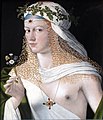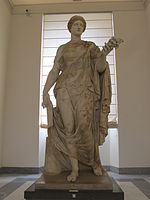
Diana is a goddess in Roman and Hellenistic religion, primarily considered a patroness of the countryside and nature, hunters, wildlife, childbirth, crossroads, the night, and the Moon. She is equated with the Greek goddess Artemis, and absorbed much of Artemis' mythology early in Roman history, including a birth on the island of Delos to parents Jupiter and Latona, and a twin brother, Apollo, though she had an independent origin in Italy.

The Italic languages form a branch of the Indo-European language family, whose earliest known members were spoken on the Italian Peninsula in the first millennium BC. The most important of the ancient Italic languages was Latin, the official language of ancient Rome, which conquered the other Italic peoples before the common era. The other Italic languages became extinct in the first centuries AD as their speakers were assimilated into the Roman Empire and shifted to some form of Latin. Between the third and eighth centuries AD, Vulgar Latin diversified into the Romance languages, which are the only Italic languages natively spoken today, while Literary Latin also survived.

Minerva is the Roman goddess of wisdom, justice, law, victory, and the sponsor of arts, trade, and strategy. She is also a goddess of warfare, though with a focus on strategic warfare, rather than the violence of gods such as Mars. Beginning in the second century BC, the Romans equated her with the Greek goddess Athena. Minerva is one of the three Roman deities in the Capitoline Triad, along with Jupiter and Juno.

In ancient Roman religion and myth, Faunus was the rustic god of the forest, plains and fields; when he made cattle fertile, he was called Inuus. He came to be equated in literature with the Greek god Pan, after which Romans depicted him as a horned god.
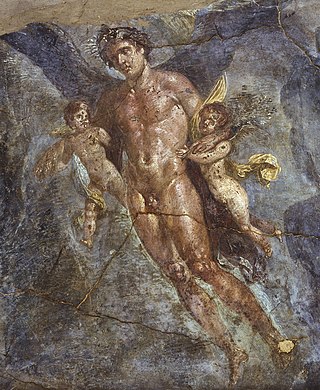
In Greek mythology and religion, Zephyrus, also spelled in English as Zephyr, is the god and personification of the West wind, one of the several wind gods, the Anemoi. The son of Eos, the goddess of the dawn, and Astraeus, Zephyrus is the most gentle and favourable of the winds, and is also associated with flowers, springtime and even procreation. In myths, he is presented as the tender breeze, and he is known for his unrequited love for the Spartan prince Hyacinthus. Although he along with Boreas are the two most prominent wind gods, their role in mythology is relatively limited.

Antheia or Anthea is one of the Charites, or Graces, in Greek mythology and the goddess of swamps and flowery wreaths. She is the daughter of Zeus and Eurynome. She was depicted in Athenian vase painting as one of the attendants of Aphrodite.

Cloacina was a goddess who presided over the Cloaca Maxima, the main interceptor discharge outfall of the system of sewers in Rome.

Libertas is the Roman goddess and personification of liberty. She became a politicised figure in the late republic. She sometimes also appeared on coins from the imperial period, such as Galba's "Freedom of the People" coins during his short reign after the death of Nero. She is usually portrayed with two accoutrements: the spear; and a phrygian cap, which she holds out in her right hand, rather than wears on her head.

Pomona was a goddess of fruitful abundance and plenty in ancient Roman religion and myth. Her name comes from the Latin word pomum, "fruit", specifically orchard fruit.
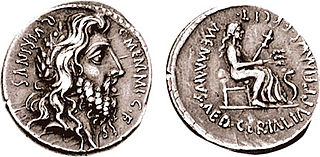
In Roman mythology and religion, Quirinus is an early god of the Roman state. In Augustan Rome, Quirinus was also an epithet of Janus, as Janus Quirinus.

Aurōra is the Latin word for dawn, and the goddess of dawn in Roman mythology and Latin poetry. Like Greek Eos and Rigvedic Ushas, Aurōra continues the name of an earlier Indo-European dawn goddess, Hausos.
Fauna is a Roman rustic goddess said in differing ancient sources to be the wife, sister, or daughter of Faunus. Varro regarded her as the female counterpart of Faunus, and said that the fauni all had prophetic powers. She is also called Fatua or Fenta Fauna.
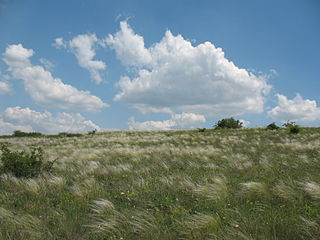
*Dyḗus, also *Dyḗus ph₂tḗr, is the reconstructed name of the daylight-sky god in Proto-Indo-European mythology. *Dyēus was conceived as a divine personification of the bright sky of the day and the seat of the gods, the *deywṓs. Associated with the vast diurnal sky and with the fertile rains, *Dyēus was often paired with *Dʰéǵʰōm, the Earth Mother, in a relationship of union and contrast.
In Roman and Greek mythology, Carpus is a minor character associated with fertility and springtime. Similarly, Karpo, one of the Horae, is the feminine equivalent of Karpos; her dominion being the fruits of the earth.

In ancient Greek religion and myth, the Anemoi were wind gods who were each ascribed a cardinal direction from which their respective winds came, and were each associated with various nature, seasons and weather conditions. They were the progeny of the goddess of the dawn Eos and her husband, the god of the dusk, Astraeus.

Primavera is a large panel painting in tempera paint by the Italian Renaissance painter Sandro Botticelli made in the late 1470s or early 1480s. It has been described as "one of the most written about, and most controversial paintings in the world", and also "one of the most popular paintings in Western art".

In Roman mythology, Dies was the personification of day. She was the daughter of Chaos and Caligo (Mist), and the counterpart of the Greek goddess Hemera.

There are a number of deities and personifications associated with seasons in various mythologies, traditions, and fiction.
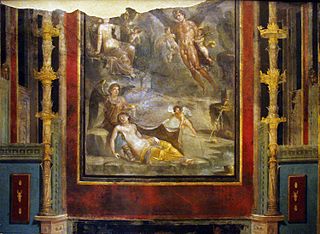
In Greek mythology, Chloris was a nymph/goddess who was associated with spring, flowers and new growth, believed to have dwelt in the Elysian Fields.

Flora and Zephyr is a 1875 oil-on-canvas painting by the French artist William-Adolphe Bouguereau. It is one of the most famous paintings of the Musée des Beaux-Arts of Mulhouse, France. Its inventory number is D.75.1.50.




